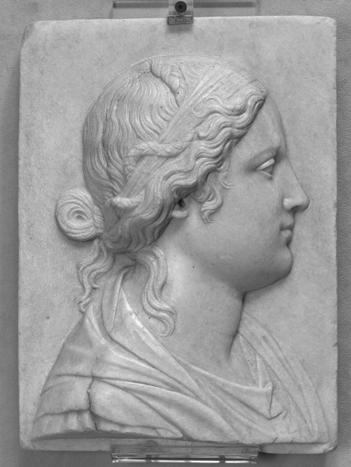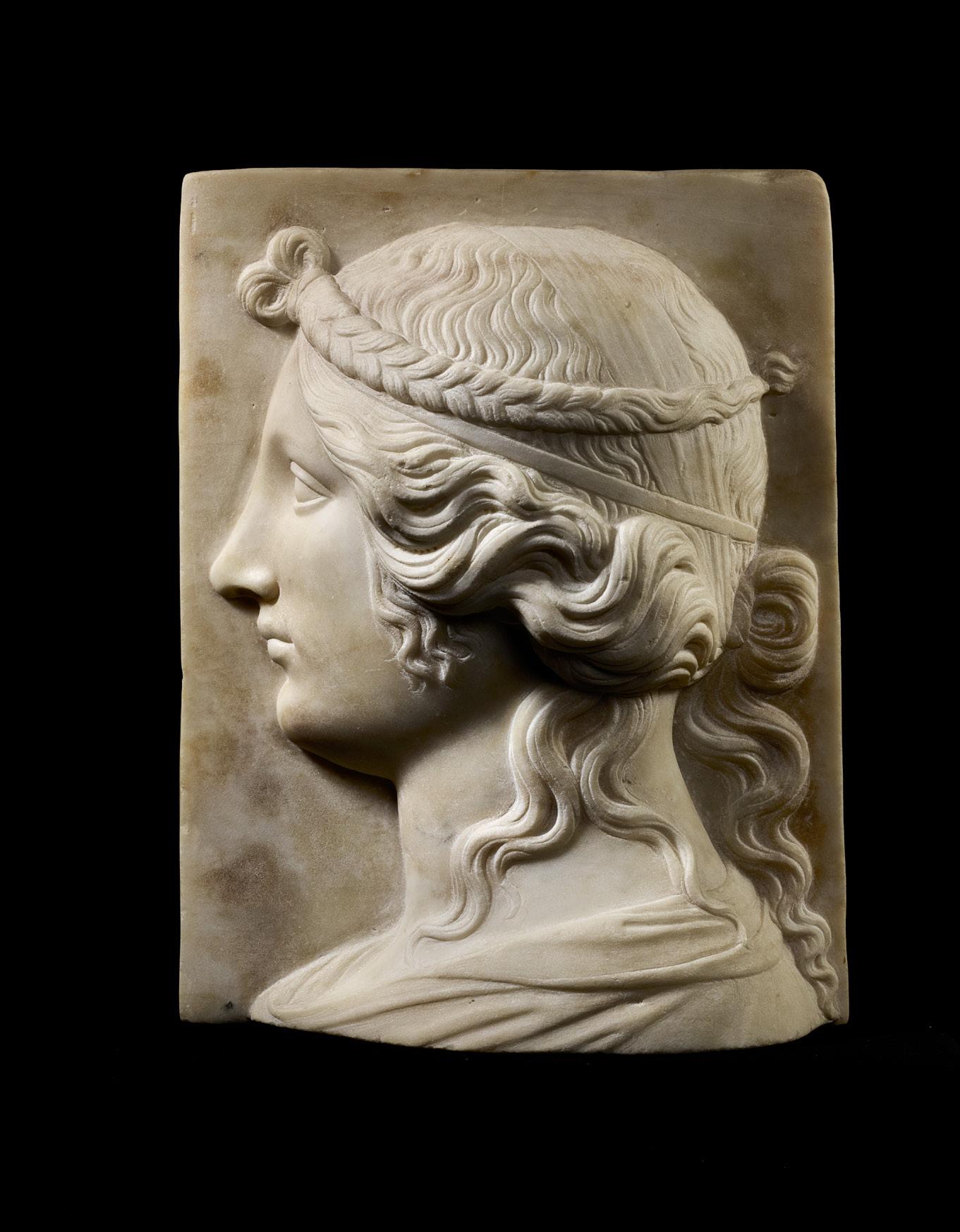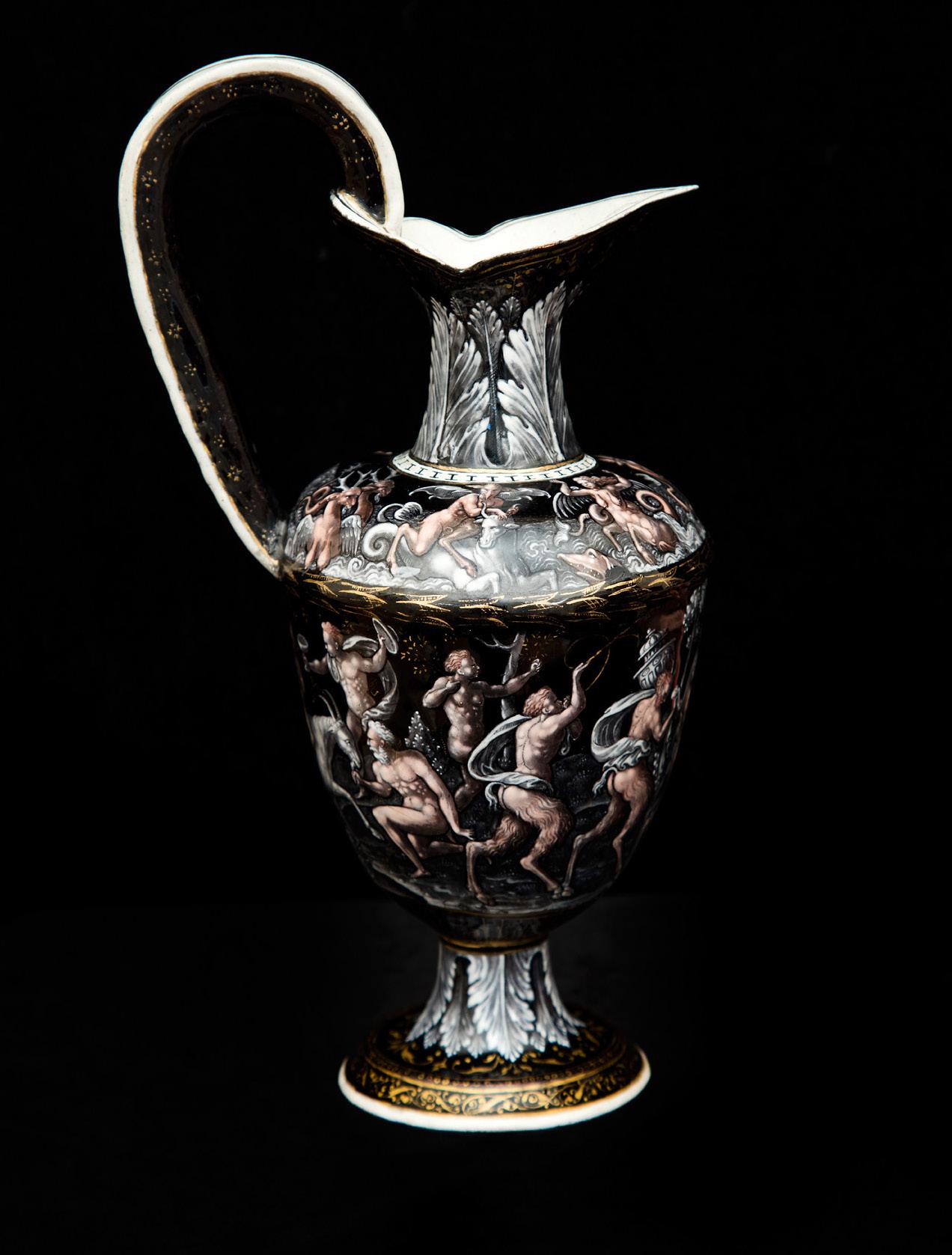
5 minute read
17 Portrait of an Idealized Woman, attributed to Simone di Bianco
from JB Test 01/22
Fig. 1. Simone Bianco, Profile Portrait of a Woman, white marble, Galleria Estense, Modena, inv. no. 2045
17
Advertisement
Despite this being a flat relief, the perspectively depicted foreshortening of the folds in the garment and the pronounced, three-dimensional plaits and curls are also typical of Simone Bianco. The relief in Modena has also recently and convincingly been included in the sculptor’s œuvre. If one compares the two reliefs, there can be no doubt that they must have been executed by one and the same sculptor. The lower border of the relief stone, similarly worked in both cases, also speaks in favour of this. To date, however, it has not been possible to compile a chronology for the few works. This was attempted by Kryza-Gersch who, however, notes: „Although the chronology proposed so far does not seem unreasonable, a word of caution should be added.As already pointed out by Anne Markham Schulz, Simone must have been able to switch his style according to the nature of his commission.“5
It is certain that Bianco started his activities before 1512 and was still alive in 1553. He received many commissions and was highly skilled in making works to meet the wishes of collectors. That this relief was created around 1530, when the artist had reached the peak of his career, is highly plausible.
The relief discussed here is also very much in keeping with Simone Bianco’s style that oscillates between all antico, on the one hand, and contemporary, on the other. Interestingly, Bianco’s idealised portraits of women, unlike his busts of men, for example, do not depict heroines from Classical Antiquity. Neither are they contemporary portraits. The style of Bianco’s work could be described as hybrid – moving little by little towards individualised portraiture from the certainty of the pictorial tradition of Antiquity. Or else his busts are creations in the style of ‘beautiful Venetian women’ to whom Palma Vecchio, Titian and Paris Bordone paid homage in their paintings, executed at the same time. Giorgione established a paradigm for this new genre of female portraiture in Venetian painting with his Laura in 1506. The identity of his model remains uncertain; the ideal of female beauty being celebrated, pars pro toto, in his depiction. Our unknown beauty with her classical profile also fits perfectly into this artistic category.
5 Kryza-Gersch, op.cit, 2013 p. 82.

18

Ewer with Bacchanal and Procession of Sea Gods
EWER WITH BACCHANAL AND PROCESSION OF SEA GODS
France (Limoges)
Third quarter of the 16th century Signed I.C., inscribed with the inv. no. G-R 772 in red ink on the underside
Grisaille and camaieu enamels Height: 27 cm
Provenance: Collection of Baron Maximilian von Goldschmidt-Rothschild, sold at auction at Parke-Bernet Galleries, New York, April 13, 1950, after the restitution to the heirs of Goldschmidt-Rothschild in 1949; The Ernest Brummer Collection: Auction sale, 16-19 October 1979, Zurich, Galerie Koller & Spink & Son (sale no. 257, cat pages 396-399); Private American Collection.
Literature: The Ernest Brummer Sale, Auction sale, 16-19 October 1979, Zurich, Galerie Koller & Spink & Son (sale no. 257, cat pages 396-399). Kjellberg, Pierre. ‘Limoges, Fontainebleau’, Connaissance des arts, July 1979, no. 329. Works of Art from the Estate of the Late Baron Max von Goldschmidt-Rothschild; Auction sale April 13 and 14, 1950, Parke-Benet Galleries, New York (sale no. 137, cat page 37). Related Literature: Wardropper, Alan. Limoges Enamels at the Frick Collection, New York 2015.
Weinhold, Ulrike. Maleremail aus Limoges im Grünen Gewölbe. Katalogbuch zur Ausstellung der Staatlichen Kunstsammlungen Dresden im SponselRaum des Neuen Grünen Gewölbes vom 27. September 2008 bis 18. Januar 2009, Munich/Berlin 2008. Baratte, Sophie. Les émaux peints de Limoges. Musée du Louvre, Paris 2000.
Verdier, Philippe. Catalogue of the Painted Enamels of the Renaissance, Baltimore 1967. Caroselli, Susan L. The Painted Enamels of Limoges: A Catalogue of the Collection of the Los Angeles County Museum of Art, Los Angeles 1993.
This finely chased copperplate ewer with grisaille painting is an outstanding work of Limousin enamel produced in the 16th century. The signature ‘IC’ is inscribed on the inner surface of the double-walled spout.
As there are certain stylistic differences between the individual elements it is now assumed that the monogram ‘IC’ is not the signature of one particular artist but maybe the mark of a workshop. It is also possible, that it refers to several enamellers with a similar or the same name who were active in the second half of the 16th century and later.
Jacques Androuet Ducerceau (before 1520-1585/86) that is one of a widespread series of designs for vessels. The composition, originally conceived as a decoration for a bowl or basin, has been transferred here to the main body of the ewer, albeit in a more compact style and with several modifications made by the enameller.
18
The ovoid body of the delicately executed ewer comprises two parts, joined by a ring in between. The narrow neck on the upper half with its curved lip at the spout, is also chased. A conically shaped foot gives the object stability; the widely arched handle ensures the necessary functionality.
Thematically, an exuberant bacchanal dominates the ewer’s decoration. It was modelled on the engraving ‘The Triumph of Bacchus’ (c. 1546, fig. 1) by the French architect and draughtsman A boisterous celebration is depicted: Silenus, drunk and exhausted from all the revelry, is seated on a donkey and supported by two elderly satyrs; another is holding Silenus’ mantle, dynamically caught in motion, that is about to slip from his shoulder. Other satyrs are playing the syrinx and trumpet. A small child and a billy goat form a second group of mounted characters. Through the light colour of the skin the figures are decoratively set off against the dark enamel background that is brightened by bushes highlighted in white and gold.
The shoulder of the ewer is decorated with a number of frolicking aquatic creatures based on ‘The Triumph of Neptune and Amphitrite’, another work by Jacques Androuet Ducerceau. A group of mythical monsters is splashing around in a skillfully depicted foaming sea of white, wavy lines on a dark background. Winged stags, a bull ridden by a fabulous masked creature with wings, a female centaur, a woman with bats’ wings, a Triton, a Nereid and another mythical creature are dancing on the waves.
The neck of the ewer, the central bead and the foot of the object are decorated with large acanthus leaves and golden tendrils. The ornamentation on the underside of the handle comprises stylised golden cornflowers on a dark ground; the contrasting white enamelled upper surface bears a black linear decoration in the form of a twisted cord.
1 Weinhold, op. cit., p. 114. 2 Ibid, p. 11.










